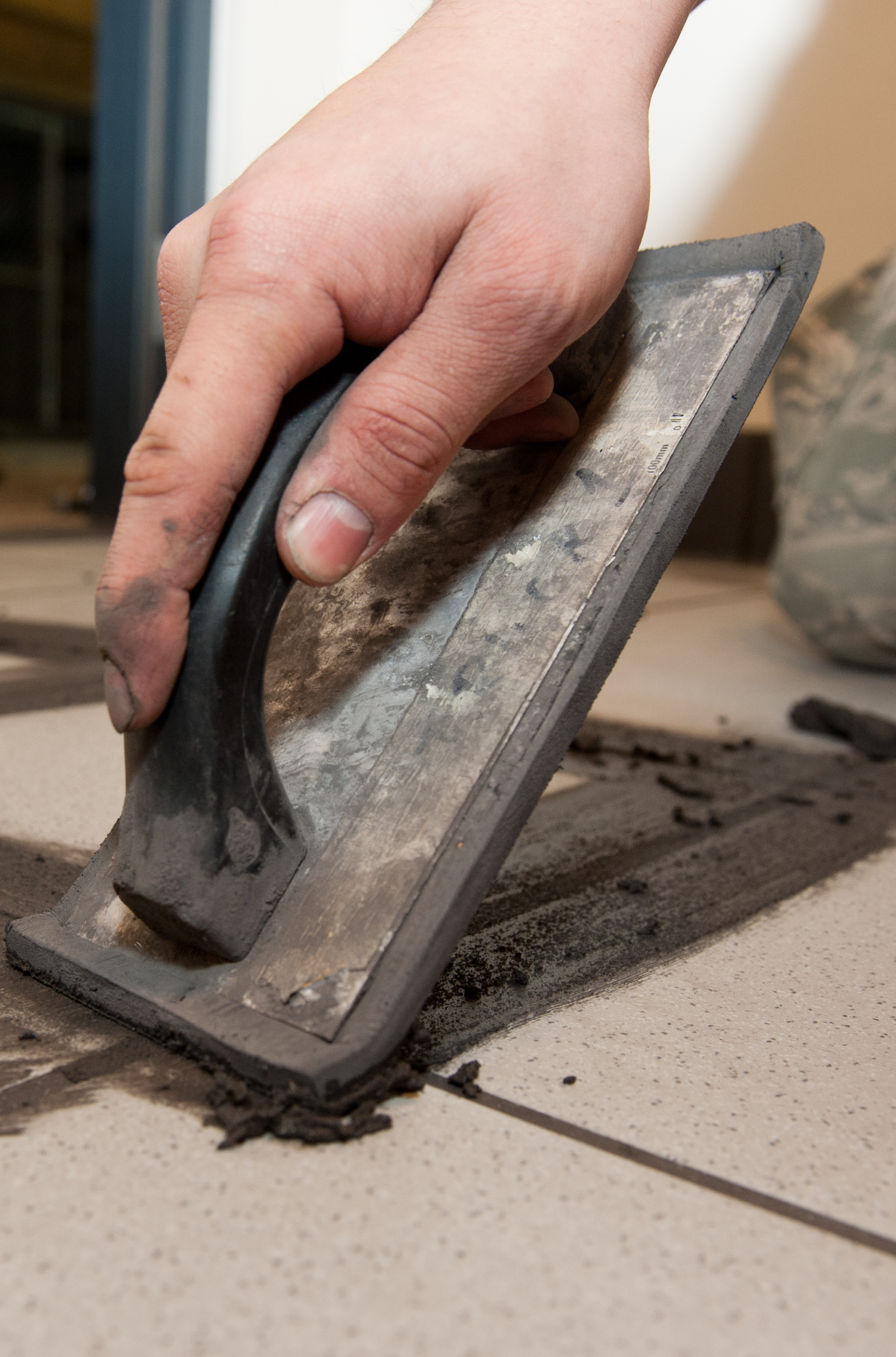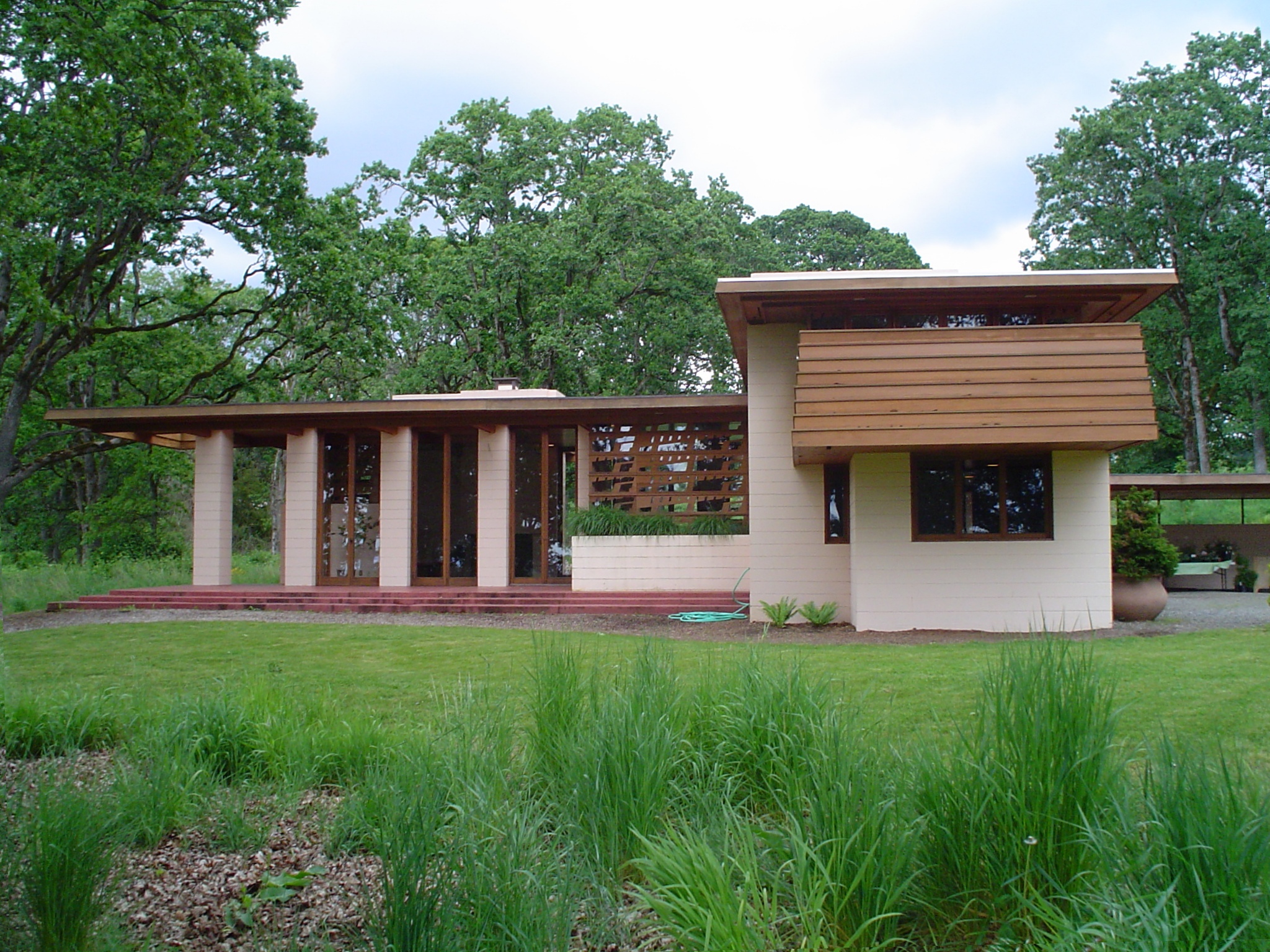|
Theodore A. Pappas House
The Theodore A. Pappas House is a Frank Lloyd Wright designed Usonian house in St. Louis, Missouri. The Pappas house was listed on the National Register of Historic Places in 1979, when it was only 15 years old. It is one of two houses in St. Louis designed by Wright, and the only Usonian Automatic in Missouri. Wright designed it between 1955 and 1959 at the Pappas’ request, and Theodore and Bette Pappas built the house together with the help of day laborers between 1960 and 1964. The Pappas house is a rambling four-bedroom house, and after the Gerald B. and Beverley Tonkens House, is the largest of the Usonian Automatics built. The entire body of the Pappas House, including the roof, is made up of plain concrete blocks standardized to a module. These blocks were placed on top of and next to one another with no Mortar (masonry), mortar. The hidden sides of each block had hollows through which steel rods were inserted, running vertically and horizontally, creating a "knit" ef ... [...More Info...] [...Related Items...] OR: [Wikipedia] [Google] [Baidu] |
Frank Lloyd Wright
Frank Lloyd Wright (June 8, 1867 – April 9, 1959) was an American architect, designer, writer, and educator. He designed more than 1,000 structures over a creative period of 70 years. Wright played a key role in the architectural movements of the twentieth century, influencing architects worldwide through his works and hundreds of apprentices in his Taliesin Fellowship. Wright believed in designing in harmony with humanity and the environment, a philosophy he called organic architecture. This philosophy was exemplified in Fallingwater (1935), which has been called "the best all-time work of American architecture". Wright was the pioneer of what came to be called the Prairie School movement of architecture and also developed the concept of the Usonian home in Broadacre City, his vision for urban planning in the United States. He also designed original and innovative offices, churches, schools, skyscrapers, hotels, museums, and other commercial projects. Wright-designed i ... [...More Info...] [...Related Items...] OR: [Wikipedia] [Google] [Baidu] |
Grout
Grout is a dense fluid which hardens to fill gaps or used as reinforcement in existing structures. Grout is generally a mixture of water, cement and sand, and is employed in pressure grouting, embedding rebar in masonry walls, connecting sections of pre-cast concrete, filling voids, and sealing joints such as those between tiles. Common uses for grout in the household include filling in tiles of shower floors and kitchen tiles. It is often color tinted when it has to be kept visible and sometimes includes fine gravel when being used to fill large spaces (such as the cores of concrete blocks). Unlike other structural pastes such as plaster or joint compound, correctly mixed and applied grout forms a water resistant seal. Although both grout and its close relative mortar are applied as a thick emulsion and harden over time, grout is distinguished by its low viscosity and lack of lime (added to mortar for pliability); grout is thin so it flows readily into gaps, while mortar ... [...More Info...] [...Related Items...] OR: [Wikipedia] [Google] [Baidu] |
Houses Completed In 1964
A house is a single-unit residential building. It may range in complexity from a rudimentary hut to a complex structure of wood, masonry, concrete or other material, outfitted with plumbing, electrical, and heating, ventilation, and air conditioning systems.Schoenauer, Norbert (2000). ''6,000 Years of Housing'' (rev. ed.) (New York: W.W. Norton & Company). Houses use a range of different roofing systems to keep precipitation such as rain from getting into the dwelling space. Houses may have doors or locks to secure the dwelling space and protect its inhabitants and contents from burglars or other trespassers. Most conventional modern houses in Western cultures will contain one or more bedrooms and bathrooms, a kitchen or cooking area, and a living room. A house may have a separate dining room, or the eating area may be integrated into another room. Some large houses in North America have a recreation room. In traditional agriculture-oriented societies, domestic animals such as ... [...More Info...] [...Related Items...] OR: [Wikipedia] [Google] [Baidu] |
Frank Lloyd Wright Buildings
Frank or Franks may refer to: People * Frank (given name) * Frank (surname) * Franks (surname) * Franks, a medieval Germanic people * Frank, a term in the Muslim world for all western Europeans, particularly during the Crusades - see Farang Currency * Liechtenstein franc or frank, the currency of Liechtenstein since 1920 * Swiss franc or frank, the currency of Switzerland since 1850 * Westphalian frank, currency of the Kingdom of Westphalia between 1808 and 1813 * The currencies of the German-speaking cantons of Switzerland (1803–1814): ** Appenzell frank ** Argovia frank ** Basel frank ** Berne frank ** Fribourg frank ** Glarus frank ** Graubünden frank ** Luzern frank ** Schaffhausen frank ** Schwyz frank ** Solothurn frank ** St. Gallen frank ** Thurgau frank ** Unterwalden frank ** Uri frank ** Zürich frank Places * Frank, Alberta, Canada, an urban community, formerly a village * Franks, Illinois, United States, an unincorporated community * Franks, Missouri, United Sta ... [...More Info...] [...Related Items...] OR: [Wikipedia] [Google] [Baidu] |
List Of Frank Lloyd Wright Works
Frank Lloyd Wright designed over 425 houses, commercial buildings and other works. "The 20th-Century Architecture of Frank Lloyd Wright" is a UNESCO World Heritage Site consisting of a selection of eight buildings across the United States designed by Wright. Table key Demolished or destroyed (also noted in "Other Information") Regularly open to the public Disputed authorship (unverified Wright design) Completed works Posthumous constructions Notable unbuilt works * University Avenue Power House, Madison, Wisconsin, Madison, Wisconsin, 1885 * Gordon Strong Automobile Objective, Sugarloaf Mountain (Maryland), Sugarloaf Mountain, Maryland, 1924 * San Marcos In The Desert, Chandler, Arizona, Chandler, Arizona, 1929 * Broadacre City, Chandler, Arizona, Chandler, Arizona, 1932–35 * Crystal Heights, Washington, DC, 1940 * Cooperative Homesteads, Madison Heights, MI, 1942 * Rogers Lacy Hotel, Dallas, Texas, 1946 * Point Park Civic Center, Pittsburgh, Pennsylvania, 1947 * An ... [...More Info...] [...Related Items...] OR: [Wikipedia] [Google] [Baidu] |
Philippine Mahogany
Philippine mahogany is a common name for several different species of trees and their wood. * Botanically, the name refers to ''Toona calantas ''Toona calantas'' is a species of tree in the mahogany family. It is found in Indonesia, the Philippines, and Thailand. It is threatened by habitat loss. It is commonly known as kalantas (also spelled calantas), lanipga (in Visayan and Bikol), ...'' in the mahogany family, Meliaceae. It is endemic to the Philippines. * In the US timber trade, it is often applied to wood of the genus '' Shorea'' in the family Dipterocarpaceae. * Rarely, it may also refer to the narra tree ('' Pterocarpus indicus'') in the legume family, Fabaceae. References {{Reflist ... [...More Info...] [...Related Items...] OR: [Wikipedia] [Google] [Baidu] |
Monochromatic
A monochrome or monochromatic image, object or palette is composed of one color (or values of one color). Images using only shades of grey are called grayscale (typically digital) or black-and-white (typically analog). In physics, monochromatic light refers to electromagnetic radiation that contains a narrow band of wavelengths, which is a distinct concept. Application Of an image, the term monochrome is usually taken to mean the same as black and white or, more likely, grayscale, but may also be used to refer to other combinations containing only tones of a single color, such as green-and-white or green-and-red. It may also refer to sepia displaying tones from light tan to dark brown or cyanotype ("blueprint") images, and early photographic methods such as daguerreotypes, ambrotypes, and tintypes, each of which may be used to produce a monochromatic image. In computing, monochrome has two meanings: *it may mean having only one color which is either on or off (also known ... [...More Info...] [...Related Items...] OR: [Wikipedia] [Google] [Baidu] |
Mortar (masonry)
Mortar is a workable paste which hardens to bind building blocks such as stones, bricks, and concrete masonry units, to fill and seal the irregular gaps between them, spread the weight of them evenly, and sometimes to add decorative colors or patterns to masonry walls. In its broadest sense, mortar includes pitch, asphalt, and soft mud or clay, as those used between mud bricks, as well as cement mortar. The word "mortar" comes from Old French ''mortier'', "builder's mortar, plaster; bowl for mixing." (13c.). Cement mortar becomes hard when it cures, resulting in a rigid aggregate structure; however, the mortar functions as a weaker component than the building blocks and serves as the sacrificial element in the masonry, because mortar is easier and less expensive to repair than the building blocks. Bricklayers typically make mortars using a mixture of sand, a binder, and water. The most common binder since the early 20th century is Portland cement, but the ancient binder l ... [...More Info...] [...Related Items...] OR: [Wikipedia] [Google] [Baidu] |
Usonian
Usonia () is a word that was used by American architect Frank Lloyd Wright to refer to the United States in general (in preference to ''America''), and more specifically to his vision for the landscape of the country, including the planning of cities and the architecture of buildings. Wright proposed the use of the adjective ''Usonian'' to describe the particular New World character of the American landscape as distinct and free of previous architectural conventions. Usonian houses "Usonian" usually refers to a group of approximately 60 middle-income family homes designed by Frank Lloyd Wright beginning in 1934 with the Willey House, with most considering the Herbert and Katherine Jacobs First House, 1937, to be the first true "Usonian." The "Usonian Homes" are typically small, single-story dwellings without a garage or much storage. They are often L-shaped to fit around a garden terrace on unusual and inexpensive sites. They are characterized by native materials; flat roo ... [...More Info...] [...Related Items...] OR: [Wikipedia] [Google] [Baidu] |
Gerald B
Gerald is a male Germanic given name meaning "rule of the spear" from the prefix ''ger-'' ("spear") and suffix ''-wald'' ("rule"). Variants include the English given name Jerrold, the feminine nickname Jeri and the Welsh language Gerallt and Irish language Gearalt. Gerald is less common as a surname. The name is also found in French as Gérald. Geraldine is the feminine equivalent. Given name People with the name Gerald include: Politicians * Gerald Boland, Ireland's longest-serving Minister for Justice * Gerald Ford, 38th President of the United States * Gerald Gardiner, Baron Gardiner, Lord Chancellor from 1964 to 1970 * Gerald Häfner, German MEP * Gerald Klug, Austrian politician * Gerald Lascelles (other), several people * Gerald Nabarro, British Conservative politician * Gerald S. McGowan, US Ambassador to Portugal * Gerald Wellesley, 7th Duke of Wellington, British diplomat, soldier, and architect Sports * Gerald Asamoah, Ghanaian-born German footba ... [...More Info...] [...Related Items...] OR: [Wikipedia] [Google] [Baidu] |
National Register Of Historic Places
The National Register of Historic Places (NRHP) is the United States federal government's official list of districts, sites, buildings, structures and objects deemed worthy of preservation for their historical significance or "great artistic value". A property listed in the National Register, or located within a National Register Historic District, may qualify for tax incentives derived from the total value of expenses incurred in preserving the property. The passage of the National Historic Preservation Act (NHPA) in 1966 established the National Register and the process for adding properties to it. Of the more than one and a half million properties on the National Register, 95,000 are listed individually. The remainder are contributing resources within historic districts. For most of its history, the National Register has been administered by the National Park Service (NPS), an agency within the U.S. Department of the Interior. Its goals are to help property owners a ... [...More Info...] [...Related Items...] OR: [Wikipedia] [Google] [Baidu] |







